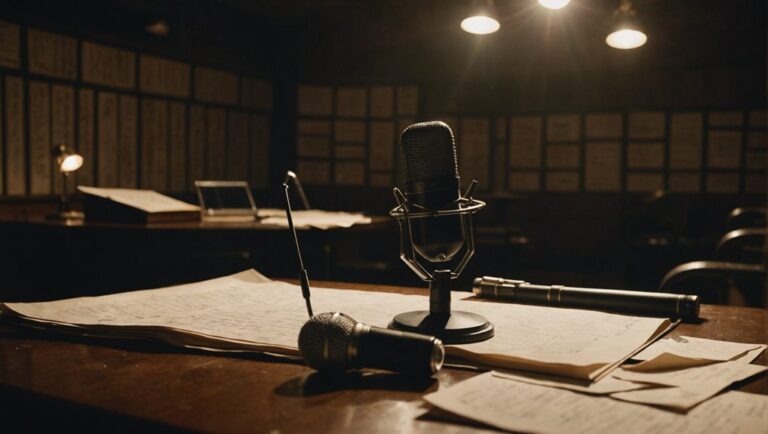What Makes a Successful Animation Project Management?
As you undertake an animation project, you're likely aware that managing it effectively is vital to its success. But what sets apart a well-managed project from a chaotic one? It's not just about meeting deadlines and staying within budget, although those are important. A successful animation project management involves a delicate balance of creative vision, technical expertise, and stakeholder expectations. You'll need to navigate the complexities of team dynamics, workflow processes, and risk management to deliver a high-quality final product. But where do you start, and what are the key elements that will make or break your project?
Key Takeaways
- Clear project scope, goals, and deliverables prevent scope creep and ensure everyone is on the same page.
- Effective team structure and roles prevent confusion, overlapping work, and missed deadlines.
- Establishing clear communication channels and collaboration tools ensures everyone is informed and aligned.
- Implementing workflow automation and identifying potential bottlenecks streamlines processes and enhances collaboration.
Defining Project Scope and Goals
To define a successful animation project's scope and goals, you'll need to start by identifying the key stakeholders, their expectations, and the project's overall objectives, which will serve as the foundation for the entire project management process.
This involves clarifying what needs to be accomplished, by when, and within what budget. Establishing clear project boundaries is vital to prevent scope creep, which can lead to delays, cost overruns, and decreased quality.
You'll need to work closely with stakeholders to define the project's scope, goals, and deliverables. This includes determining what's included and excluded from the project, as well as identifying any assumptions or dependencies.
By setting clear boundaries and expectations, you can guarantee that everyone involved in the project is on the same page and working towards the same objectives.
Effective scope definition also involves identifying potential risks and developing strategies to mitigate them. By doing so, you can proactively manage scope creep and guarantee that your project stays on track.
Building a Strong Team Structure
With a clear project scope and goals in place, you're now ready to build a strong team structure that can effectively execute your animation project, and this starts by identifying the key roles and responsibilities required to deliver the project's objectives.
Identify the essential functions and skills needed to bring your project to life, and group them into departments such as animation, design, and production. Each department should have a clear lead who can oversee the work and guarantee it aligns with the project's overall vision.
Department Heads will be responsible for managing their team's workload, setting deadlines, and allocating resources. Team Leads, on the other hand, will focus on guiding their team members, providing feedback, and verifying that tasks are completed to a high standard.
Establishing clear roles and responsibilities will prevent confusion, overlapping work, and missed deadlines. By defining each team member's role and expectations, you'll create a cohesive and efficient team structure that can deliver a successful animation project. This will also enable you to effectively delegate tasks and trust that they'll be executed by the right person, with the right skills.
Effective Communication Strategies
To guarantee your animation project stays on track, you'll need to establish clear team goals and communicate them effectively to your team members.
This involves setting specific, measurable objectives and making sure everyone understands their role in achieving them.
Clear Team Goals
Establishing clear team goals is crucial for effective communication, as it enables you and your team to focus on the same objectives and work collaboratively towards a shared vision.
When everyone is on the same page, you can foster team unity and drive progress towards your animation project's success.
To achieve goal clarity, define specific, measurable, achievable, relevant, and time-bound (SMART) objectives that align with your project's overall strategy.
Break down larger goals into smaller, manageable tasks to guarantee each team member understands their role and responsibilities.
As the project manager, it's your responsibility to communicate these goals effectively to your team.
Use collaboration tools, such as project management software or team meetings, to guarantee everyone is informed and aligned.
Regularly review and update your team goals to reflect changes in the project scope or timeline.
By maintaining clear team goals, you'll promote a sense of direction and purpose among your team members, ultimately leading to increased productivity and a higher quality final product.
With clear goals, you'll be able to track progress, make informed decisions, and drive your animation project forward with confidence.
Consistent Progress Updates
Regularly scheduling consistent progress updates is essential for keeping your team informed, aligned, and motivated throughout the animation project lifecycle. By doing so, you'll maintain project visibility, ensuring everyone is on the same page. This, in turn, fosters stakeholder trust, as they receive timely updates on the project's status.
To implement consistent progress updates, establish a regular cadence of meetings, such as weekly or bi-weekly team check-ins. During these meetings, review project milestones, discuss challenges, and set clear goals for the next period.
Additionally, leverage project management tools to track progress and share updates with team members and stakeholders.
When sharing updates, focus on key performance indicators (KPIs) and metrics that matter most to your project. This will help you communicate effectively with stakeholders and team members, ensuring everyone understands the project's progress and any adjustments needed.
Managing Creative Workflow Processes
By integrating project management tools and techniques into your creative workflow, you'll be able to streamline processes, enhance collaboration, and guarantee that your animation project stays on track.
This is especially vital when dealing with creative roadblocks, which can quickly derail a project if not addressed promptly.
By implementing workflow automation, you can minimize the risk of roadblocks and certify that your team is working efficiently.
To manage your creative workflow effectively, you need to identify potential bottlenecks and implement solutions to mitigate them.
This might involve setting up automated workflows for repetitive tasks, such as data entry or file organization, freeing up your team to focus on high-level creative decisions.
You should also establish clear communication channels and define roles and responsibilities to avoid confusion and overlapping work.
Setting Realistic Timelines and Budgets
When setting realistic timelines and budgets for your animation project, you'll need to establish key milestones that align with your project's scope and goals.
This involves identifying critical tasks, allocating resources wisely, and creating a schedule that allows for flexibility and contingencies.
Establishing Key Milestones
How do you determine the most effective way to allocate resources and prioritize tasks to guarantee your animation project is completed on time and within budget?
Establishing key milestones is vital in achieving this goal. By breaking down your project into manageable chunks, you can create a roadmap for success. Utilize milestone templates to help you identify critical stages in your project, such as script finalization, character design completion, and animation production start dates.
These templates will serve as a guide to confirm you're on track to meet your deadlines.
Incorporate timeline markers to visualize your project's progression. These markers will help you pinpoint potential bottlenecks and make adjustments accordingly.
By setting realistic milestones, you'll be able to allocate resources more efficiently and prioritize tasks effectively. This strategic approach will enable you to make informed decisions, collaborate with your team more effectively, and ultimately deliver a high-quality animation project on time and within budget.
Allocating Resources Wisely
To allocate resources wisely, you must set realistic timelines and budgets that account for every stage of your animation project, from pre-production to final delivery.
This involves breaking down your project into manageable tasks, estimating the time and resources required for each task, and assigning specific deadlines and budgets to each stage.
Effective resource allocation is critical to guaranteeing that your project stays on track and within budget.
When developing your budgeting strategies, consider the scope of your project, the skills and expertise of your team, and the resources required to complete each task.
Be sure to build in contingencies for unexpected expenses or delays.
Collaborate with your team to identify potential roadblocks and develop strategies for mitigating risks.
By taking a strategic and technical approach to resource allocation, you can guarantee that your project is completed on time, within budget, and to the desired quality.
Identifying and Mitigating Risks
By regularly reviewing your project's scope, timeline, and budget, you'll be better equipped to identify potential risks that could derail your animation project.
This proactive approach enables you to anticipate and mitigate risks before they become major issues.
Effective risk assessment is vital in animation project management, as it allows you to identify potential problems and develop strategies to address them.
Technical risks: Identify potential technical issues that could impact your project, such as software compatibility problems or equipment failures.
Creative risks: Assess the creative aspects of your project, including the potential for miscommunication or differing artistic visions.
Logistical risks: Consider logistical challenges, such as tight deadlines or limited resources.
Collaborating With Stakeholders and Clients
Effective collaboration with stakeholders and clients is essential in animation project management, as it guarantees that their needs and expectations are met, and that you're able to deliver a high-quality final product that aligns with their vision.
To achieve this, you need to establish open and transparent communication channels with all stakeholders and clients. This involves actively listening to their concerns, addressing their questions, and providing regular updates on the project's progress.
Building stakeholder trust is pivotal in this process. You can do this by being responsive to their needs, delivering on your promises, and maintaining a high level of professionalism.
It's also essential to understand the client's vision and goals, and to confirm that your team is aligned with these objectives. By doing so, you'll be able to deliver a final product that meets their expectations and exceeds their needs.
Regular meetings, progress reports, and feedback sessions can help you stay on track and confirm that everyone is working towards the same goal.
Maintaining Quality Control Measures
With a solid foundation of collaboration and communication in place, you're now positioned to implement quality control measures that guarantee your animation project meets the high standards you've established with your stakeholders and clients.
To certify consistency and excellence, you'll need to establish clear quality metrics that align with your project's goals and objectives.
Develop a style guide: Create a detailed style guide that outlines the visual and technical specifications for your animation project. This will verify that all team members are on the same page and that the final product meets your quality standards.
Establish quality checkpoints: Set up regular quality checkpoints throughout the production process to review and assess the project's progress. This will help identify and address any issues or discrepancies early on.
Conduct peer reviews: Encourage team members to review and provide feedback on each other's work. This will help catch any errors or inconsistencies and verify that the final product meets your quality metrics.
Frequently Asked Questions
What Metrics Measure Project Management Success?
When evaluating project success, you track key performance indicators like budget variance, timeline flexibility, and scope creep. These metrics help you gauge effectiveness and identify areas for improvement in your management strategy.
How to Handle Team Member Burnout and Turnover?
You proactively manage team member burnout by prioritizing time management and workload delegation. Regularly assess workloads, delegate tasks effectively, and encourage open communication to prevent overwork and turnover, ensuring a healthy and productive team.
Can AI Tools Replace Human Project Managers?
You're considering AI tools to replace human project managers, but you must weigh AI limitations against project complexities. While AI excels in data analysis, it can't replicate human intuition, creativity, or emotional intelligence in managing complex projects.
What Role Does Sustainability Play in Animation Projects?
When managing animation projects, you'll prioritize eco-friendly pipelines, integrating sustainable practices into every stage. Conducting regular carbon footprint analysis helps you identify areas for improvement, ensuring your project's environmental impact is minimized and responsible.
How to Manage Last-Minute Client Change Requests?
You're facing a last-minute client change request, now you need to adapt. Establish clear change protocols to manage the impact. Certify effective client communication to confirm the revised scope and timeline.
Conclusion
You've defined your project scope, built a strong team, and established effective communication strategies.
You've managed your workflow, set realistic timelines and budgets, and mitigated risks.
By collaborating with stakeholders and maintaining quality control measures, you'll deliver a high-quality final product that meets client objectives.
With a strategic approach to animation project management, you'll guarantee consistency and excellence throughout the project lifecycle, setting yourself up for success and building trust with your clients.







